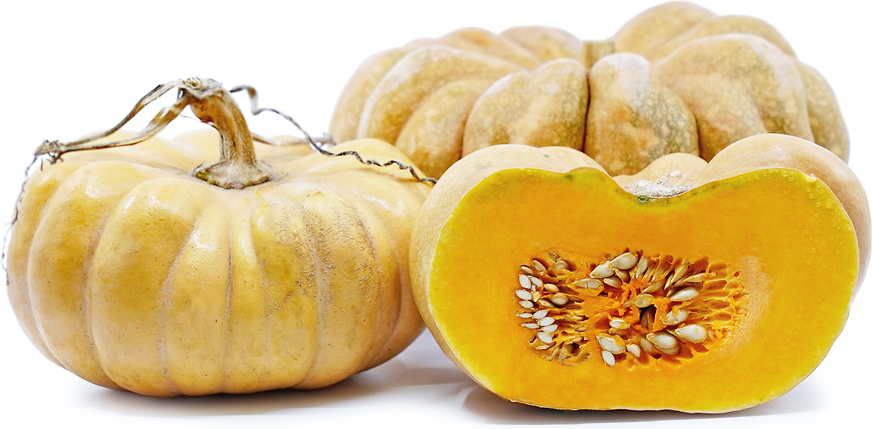


Thai Pumpkin Squash
Estimated Inventory, lb : 0
Description/Taste
Thai pumpkins are medium to large in size, averaging 8 to 14 pounds, and have a flattened, round to ovate shape. The rind is deeply ribbed, textured, firm, and thin, sometimes covered in a powdery coating. When young, Thai pumpkins are dark green, covered in tan speckles and mottling, and as the pumpkin matures in storage, it transitions into to a uniform tan to light brown hue. Underneath the rind, the flesh is dense, bright orange-yellow, and has a drier consistency, encasing a small central cavity filled with ivory seeds and stringy fibers. Thai pumpkins develop a smooth, creamy, and soft texture when cooked and have a rich, sweet, and subtle, spice-like flavor.
Seasons/Availability
Thai pumpkins are available year-round in Thailand and are available in the fall in the United States.
Current Facts
Thai pumpkins, botanically classified as Cucurbita moschata, are large, ridged fruits that grow on a vining plant belonging to the Cucurbitaceae family. The name Thai pumpkin is a general descriptor used to encompass multiple varieties of pumpkins commonly grown in Thailand. Pumpkins have become a favored secondary crop in Thailand and are planted as an additional source of income. The thick-fleshed pumpkins are valued for their resistance to disease, high yields, large size, and easy-to-grow nature. Thai pumpkins are also being cultivated in the United States through exotic farms and in home gardens as a specialty variety. The main variety of Thai pumpkin that is cultivated in both Thailand and the United States is also known as Rai Kaw Tok.
Nutritional Value
Thai pumpkins are a good source of vitamins A and C, which are antioxidants that strengthen the immune system, reduce inflammation, and boost collagen production within the skin. The pumpkins also provide potassium to help balance fluid intake, manganese to activate enzymes in the body, and some fiber to stimulate the digestive tract.
Applications
Thai pumpkins are best suited for cooked applications such as steaming, sautéing, roasting, baking, simmering, and frying. The pumpkin’s thin skin does not need to be peeled before consumption and is considered edible once cooked. When prepping, Thai pumpkins can be cut in half, deseeded, and then cubed, sliced, or quartered. The seeds can also be saved and roasted as a salty snack. Thai pumpkins can be used as a substitute in recipes calling for kabocha or butternut squash, and are frequently incorporated into soups, stews, and curries, or sliced and mixed into stir-fries. In Thailand, Thai pumpkins are commonly stir-fried with eggs to create a nutritious meal for children. The thick flesh can also be battered and fried into tempura, roasted and stirred into grain bowls, cooked into gratin, or steamed as a simple side dish. In addition to savory applications, Thai pumpkins can be used to flavor baked goods, cooked into a custard, or made into a puree for extended use. Thai pumpkins pair well with coconut milk, chile peppers, aromatics such as ginger, garlic, and onions, limes, lemongrass, herbs such as Thai basil, mint, and cilantro, carrots, bell peppers, and green beans. Whole Thai pumpkins will keep 1 to 3 months when stored in a cool and dry place.
Ethnic/Cultural Info
In Thailand, Thai pumpkins are popularly steamed in a dish known as Sankaya Fak Thong or Thai pumpkin custard. The word Sankaya translates to mean “coconut custard” and fak thong translates to mean “pumpkin.” The sweet dish is comprised of a hollowed Thai pumpkin filled with a coconut and egg custard-like mixture, which is steamed and served whole or sliced. Once cooked, the entire pumpkin is edible including the skin, and when the pumpkin is sliced, the custard also holds its shape creating a visually appealing dish. Sankaya Fak Thong is sold at local markets and restaurants across Thailand and is prized for its unique aesthetic and sweet, rich flavor. The dish is a favorite of both locals and tourists, and the recipe has also been widely adapted through online bloggers, becoming popular among Thai food enthusiasts in the United States.
Geography/History
Pumpkins are a type of squash native to the Americas and was first introduced into Asia by explorers in the sixteenth century. While the exact history of Thai pumpkins is unknown, pumpkin cultivation in Thailand has significantly increased in the past decade, expanding the number of available varieties and breeding programs. Today Thai pumpkins are grown in regions throughout Thailand and are also cultivated in other countries in Southeast Asia, including Laos and the Philippines. The pumpkins are also being grown through specialty farms and in home gardens in warm regions of the United States. The Thai pumpkins featured in the photograph above were grown at Thao Farms in Fresno, California, which is a family owned and operated specialty farm since 1979.
Recipe Ideas
Recipes that include Thai Pumpkin Squash. One
| Happy Acres Blog |
|
Maple Pumpkin Custard |
| Foodie Crush |
|
Five Ingredient Thai Pumpkin Soup |
| Group Recipes |
|
Thai Pumpkin Pudding |
| Flavor the Moments |
|
Thai Pumpkin Curry |
| She Simmers |
|
Steamed Pumpkin Cake |




